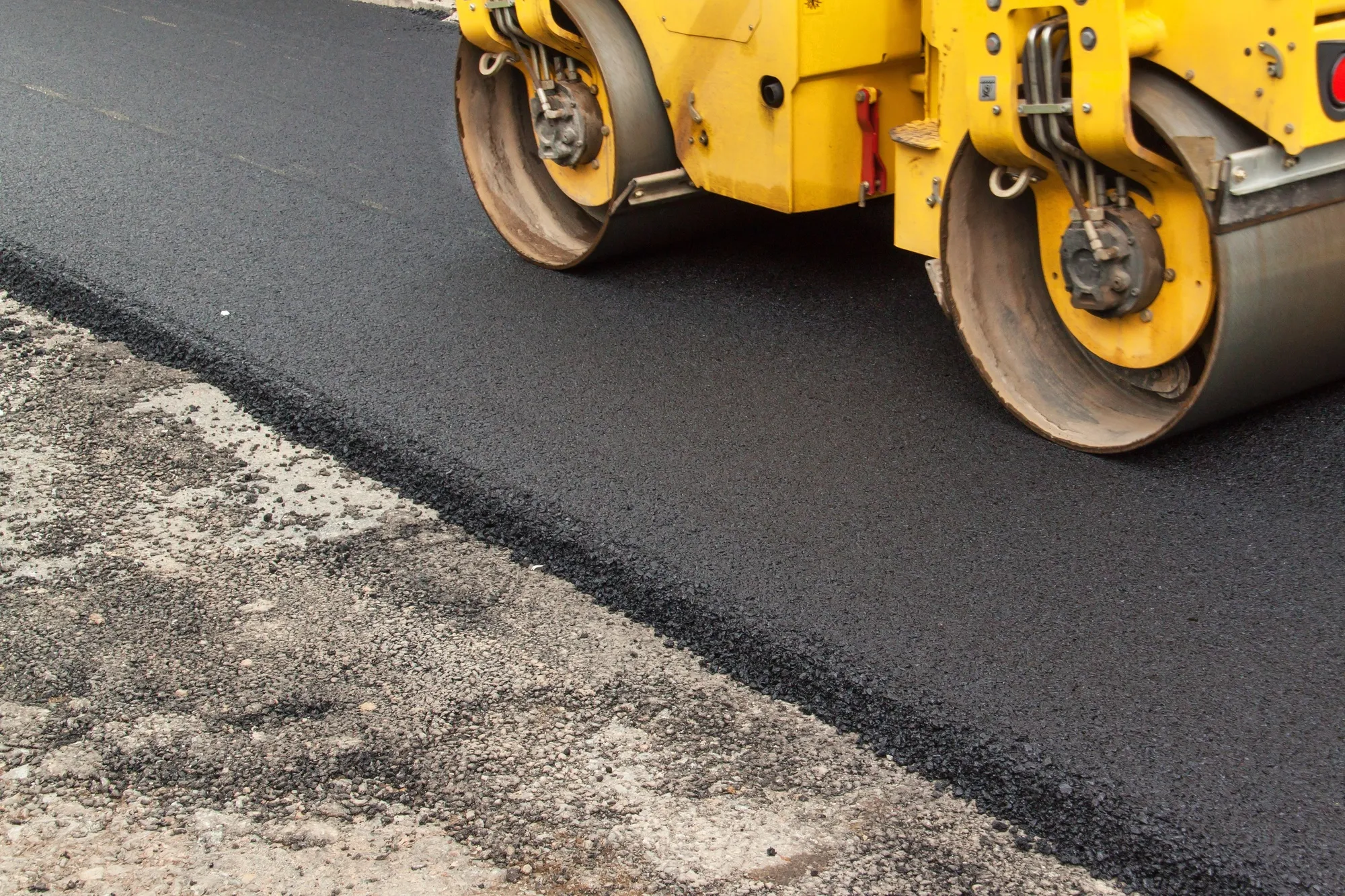Asphalt roads: they’re everywhere, providing smooth journeys and connecting communities. But have you ever wondered what goes into creating these marvels of engineering? This comprehensive guide takes you through every step of asphalt concrete road construction, from the initial planning stages to the finishing touches. Whether you’re a seasoned professional or simply curious about the world beneath your wheels, get ready to pave your way through the fascinating process of building roads that stand the test of time.
Process Involved in Construction of Asphalt Concrete Road
Constructing an asphalt concrete road is a meticulously orchestrated process, akin to layering a cake. Each step plays a crucial role in ensuring the road’s durability, strength, and longevity. Let’s break down the key stages:
Step 1: Getting Ready for the Road – Site Preparation
Just as a painter prepares a canvas, the initial step involves prepping the site for the road ahead:
- Clean Up: The area is cleared of any obstacles, including trees, vegetation, existing pavement, or debris.
- Grading and Sloping: The ground is then graded and sloped to ensure proper drainage. This prevents water from pooling on the road surface, which can lead to premature deterioration.
- Sub-Base Support: A sub-base layer of compacted soil or gravel is often added for enhanced stability. This helps to distribute the weight of the road evenly, preventing settling and cracking.
Step 2: Laying the Groundwork – The Base Layer
Think of the base layer as the road’s robust foundation. It bears the brunt of the traffic load:
- Spreading and Compacting: Crushed rock or gravel is spread evenly over the prepared sub-base and compacted using heavy rollers. This creates a dense, solid base that can withstand the weight of vehicles.
Step 3: Adding Flexibility – The Binder Course
The binder course introduces a vital element – flexibility. This layer acts as a buffer between the rigid base and the surface layer:
- Asphalt Binder Mix: This layer consists of asphalt cement (the sticky black binder) and aggregates like sand or gravel.
- Distributing Weight and Handling Temperature: The binder course distributes the weight of vehicles more evenly over the base layer and allows the road to expand and contract with temperature changes, preventing damage.
Step 4: The Icing on the Cake – The Surface Course
This is the layer we interact with directly – the smooth, topmost layer of the road:
- Fine Aggregate for Smoothness: The surface course utilizes a finer mix of aggregates than the binder course, resulting in a smoother, more refined driving surface.
- Final Compaction: Like the previous layers, the surface course is compacted to eliminate air pockets, ensuring a durable and long-lasting finish.
Step 5: Packing it All In – Compaction
Compaction is crucial throughout the entire process. Each layer, from the sub-base to the surface course, undergoes meticulous compaction using heavy rollers. This removes air pockets within the asphalt, increasing its density and strength. Proper compaction is essential for a durable and long-lasting road surface.
Step 6: Connecting the Pieces – Joints and Transitions
Roads are rarely constructed as a single, continuous stretch. Joints and transitions to bridges, sidewalks, or other surfaces are necessary:
- Seamless Connections: These areas require special attention to prevent cracking and water damage. They are carefully sealed to create a seamless transition and maintain a smooth driving surface.
Step 7: Guiding the Way – Pavement Markings
Once the asphalt has cured and hardened, the final touch is added – pavement markings:
- Essential Guidance for Traffic: Lane dividers, crosswalks, stop lines, and edge lines are applied to provide clear guidance for drivers and pedestrians, ensuring safe and efficient traffic flow.
And there you have it! Building a durable and smooth asphalt concrete road is a testament to meticulous planning, skilled execution, and quality materials. Each layer works in harmony to create a surface that can withstand the constant demands of traffic and the elements. The next time you drive on a freshly paved road, take a moment to appreciate the intricate dance of engineering that went into its creation.
What are the Essential Steps in Asphalt Road Construction?
While the previous section provided a detailed overview, let’s simplify the essence of asphalt road construction. Building a lasting asphalt road goes beyond merely pouring blacktop. Here’s a breakdown of the key steps:
- Site Preparation: Laying the groundwork is crucial. This involves clearing the site, ensuring proper drainage, and creating a stable sub-base.
- Asphalt Base Course: The base course is the road’s backbone, providing strength and support. Crushed stone or gravel is compacted to form this foundation.
- Binder Course: This layer, composed of asphalt cement and aggregates, provides flexibility and helps distribute the weight of vehicles.
- Surface Course: The topmost layer, made with a finer aggregate mix, creates the smooth, durable driving surface we’re familiar with.
- Quality Control: Ensuring quality throughout the process is paramount. This includes material testing, thickness checks, and ongoing inspections.
Each of these steps is essential for creating a road that can withstand the test of time and traffic.
How to Ensure Quality Control in Asphalt Road Construction
Quality control (QC) is the unsung hero of asphalt road construction. It’s the difference between a road that lasts for decades and one that crumbles within a few years. Implementing a robust QC program is essential for achieving durable, safe, and cost-effective asphalt pavements. Let’s delve into the key aspects of ensuring top-notch quality:
1. Material Testing: Getting the Right Ingredients
Just like a chef meticulously selects ingredients for a recipe, asphalt road construction demands high-quality materials. This involves rigorous testing of both the asphalt mix and the aggregates:
- Gradation Tests: These tests analyze the size distribution of aggregates. Proper gradation ensures the asphalt mix is dense, stable, and resistant to deformation.
- Asphalt Content: The percentage of asphalt binder in the mix directly affects the pavement’s durability, flexibility, and resistance to moisture damage.
- Density and Voids Analysis: These tests assess the amount of air voids in the compacted asphalt. Achieving the optimal air void content is crucial for preventing premature cracking and ensuring long-term performance.
2. Construction Monitoring: Keeping an Eye on the Process
Maintaining a watchful eye throughout the construction process is essential. This involves monitoring key aspects such as:
- Spreading and Compaction: Inspectors ensure the asphalt is evenly spread at the correct thickness and compacted to the specified density. Proper compaction is crucial for maximizing the asphalt’s strength and longevity.
- Temperature Control: Asphalt must be placed and compacted within a specific temperature range to achieve optimal density and performance. Monitoring and controlling temperature is essential for preventing issues like rutting and cracking.
- Joint Construction: Joints between paving passes or sections require special attention to prevent water infiltration and premature deterioration. Inspectors ensure joints are properly constructed and sealed to maintain a smooth, watertight surface.
3. Performance Evaluation: Putting the Road to the Test
Once the road is constructed, the evaluation doesn’t stop there. Performance testing helps assess the road’s long-term durability and identify any potential issues:
- Ride Quality: Specialized equipment measures the smoothness of the road surface. This helps to identify areas that may require further attention to ensure a comfortable ride for drivers.
- Skid Resistance: A road’s skid resistance is crucial for safety, especially during wet weather. Tests are conducted to measure the friction between tires and the pavement surface, ensuring adequate skid resistance.
- Structural Integrity: Load-bearing tests are performed to evaluate the road’s ability to handle the weight of traffic over time. This helps to identify any potential weaknesses in the pavement structure.
4. Asphalt Core Testing: A Deeper Look
Asphalt core testing provides valuable insights into the road’s structure and composition. Cores are extracted from the pavement and taken to a laboratory for analysis:
- Layer Thickness Verification: Core samples allow engineers to verify the thickness of each pavement layer, ensuring it meets the design specifications.
- Density and Composition Analysis: Laboratory tests can determine the density, air voids, and asphalt content of the core samples, providing further insights into the pavement’s quality.
5. Quality Assurance: Building a Culture of Excellence
Quality control is not merely a checklist; it’s about fostering a culture of excellence throughout the entire construction process:
- Trained Professionals: Employing experienced and certified inspectors and technicians is crucial for implementing effective quality control measures.
- Documentation and Record-Keeping: Maintaining detailed records of materials, test results, and construction processes provides valuable data for future reference and performance analysis.
- Continuous Improvement: Regularly reviewing and refining quality control procedures based on data and feedback helps to identify areas for improvement and enhance the overall quality of asphalt pavement construction.
Tips for Successful Quality Control:
- Collaboration and Communication: Encourage open communication and collaboration between all stakeholders involved in the project, from the design engineers to the field crew.
- Utilize Technology: Embrace technological advancements in quality control, such as digital data collection, GPS-based monitoring, and automated testing equipment, to improve efficiency and accuracy.
- Sustainability Considerations: Incorporate sustainable practices into the quality control process by promoting the use of recycled materials, reducing waste, and minimizing the environmental impact of construction activities.
By adhering to comprehensive quality control measures, we ensure the construction of durable, safe, and high-performing asphalt pavements that contribute to a well-maintained transportation infrastructure.
Innovations Shaping the Future of Asphalt Roads
The world of asphalt roads is undergoing a significant transformation. Driven by technological advancements and a growing emphasis on sustainability, the future of road construction is paved with innovation. Let’s explore some of the groundbreaking trends shaping the industry:
Going Digital: Smarter Asphalt Plants
The digital revolution is sweeping through asphalt production, ushering in an era of smarter, more efficient asphalt plants. Specialized software solutions are optimizing various aspects of plant operations, including:
- Material Management: Digital tools track material inventory levels, predict demand, and optimize delivery schedules, minimizing waste and ensuring a consistent supply of materials.
- Production Optimization: Advanced algorithms adjust production parameters in real time based on factors like weather conditions, material properties, and project specifications, maximizing efficiency and reducing energy consumption.
- Quality Control Integration: Digital platforms integrate seamlessly with quality control testing equipment, automating data collection, analysis, and reporting, which streamlines the QC process and enhances accuracy.
Example: Companies like PlantDemand.com offer cloud-based software solutions tailored specifically for asphalt plants, providing real-time data insights, production optimization tools, and comprehensive reporting features.
The Rise of the Machines: Automation and Robotics
The construction industry is witnessing a surge in automation, and asphalt road construction is no exception. Autonomous vehicles, robots, and drones are changing the landscape of road building, bringing a host of benefits:
- Enhanced Safety: Automating hazardous tasks, such as paving operations in high-traffic areas, significantly reduces the risk of accidents and improves worker safety.
- Increased Efficiency: Autonomous machines can work continuously without breaks, increasing productivity and reducing project completion times.
- Improved Accuracy: Robots and automated systems perform tasks with a high degree of precision and consistency, leading to higher-quality road surfaces.
Examples: Companies like Volvo Construction Equipment and Built Robotics are developing autonomous asphalt paving equipment that can operate without human intervention, while drone technology is increasingly being used for surveying, inspection, and monitoring purposes.
Green Roads Ahead: Sustainability Takes Center Stage
Sustainability is no longer optional; it’s a necessity. The asphalt industry is embracing eco-friendly practices and materials to minimize its environmental footprint:
- Recycled Asphalt Pavement (RAP): Using RAP in asphalt mixes conserves natural resources, reduces landfill space, and lowers greenhouse gas emissions.
- Warm-Mix Asphalt (WMA): WMA technologies lower the production temperature of asphalt, reducing energy consumption and emissions.
- Bio-Based Binders: Researchers are exploring the use of bio-based materials, such as lignin and vegetable oils, as sustainable alternatives to traditional petroleum-based asphalt binders.
Staying Ahead of the Curve: Embracing a Connected Future
The future of asphalt roads is interconnected. Integrating emerging technologies and data-driven insights will be crucial for optimizing road construction and maintenance:
- Building Information Modeling (BIM): BIM technology creates digital representations of roads, enabling better collaboration, clash detection, and asset management throughout the lifecycle of a road project.
- Smart Infrastructure: Sensors embedded in roads can collect data on traffic flow, pavement conditions, and environmental factors, providing valuable insights for optimizing maintenance schedules and improving road safety.
- Predictive Analytics: Data analytics and machine learning algorithms can predict pavement deterioration patterns, allowing for proactive maintenance and extending the lifespan of roads.
The asphalt road construction industry is on the cusp of a new era, driven by innovation and a commitment to sustainability. By embracing these advancements, we can pave the way for safer, more durable, and environmentally friendly roads for generations to come.
If you’re looking for a detailed step-by-step guide on how to make highway in civil, we’ve got you covered! This article covers everything you need to know, from planning to construction. If you’re wondering what hoarding meaning in construction is, we have a comprehensive explanation in our article.
- Small Corner Kitchen Ideas: Maximize Style In Tight Spaces - January 1, 2026
- Kitchen Counter Corner Ideas: Style Your Awkward Angles Now - December 31, 2025
- Best Finish for Butcher Block Countertops: Choosing the Right Option - December 30, 2025










